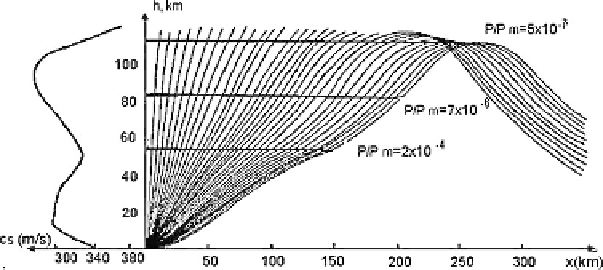Geoscience Reference
In-Depth Information
Fig. 15.3.
A set of acoustic rays from a point source located on the ground surface.
After [23]
Nonlinear Acoustic Wave
The nonlinearity can have a substantial effect on pulse damping. When the
wave vertically ascends in the lossless inhomogeneous atmosphere, the wave's
energy
ρv
2
= const is conserved in the first approximation. There is a height
where the gas speed in the wave becomes comparable to the sound speed and
at this level, a shock wave occurs [31].
The interesting nonlinear effect of an acoustic wave with finite amplitude
was considered in ([23], [31]). The numerical calculations in the ray approxi-
mation showed that nonlinear distortions of a spherical wave do not depend
on the ray's initial angle (i.e. that angle at which the ray originates from a
point source) [23]. The shock front is formed at the same height for all the rays
[24]. The field amplitude at a fixed height weakly depends on the ray's ini-
tial angle, whereas the formation of shock waves only depends on the height.
The right side of Fig. 15.3 demonstrates a set of acoustic rays produced by a
point source located on the ground surface. The height distribution of sound
velocity used in the calculations is shown in the left side of the figure. For the
calculated ray structure, pressure peak values were defined as a function of
the initial angle for various heights. The location of the isobars is shown in
Fig. 15.3 by horizontal lines. One can see that the isobars become horizontal.
It decreases the spherical acoustic beam divergence and can increase a value of
the magnetic pulse at the distances of
≈
100-200 km from the acoustic beam
axis.
When propagating, the pulse undergoes changes in its shape and duration
(see e.g. [7]). The pulse duration is about three times longer than the duration
found above with the linear theory formulae. It lasts for about 3
,
10 and 20 s,
respectively, for 100
,
150 and 200 km.
At the front of such a nonlinear wave there can be an appreciable change
of chemical kinetics of both neutral and ionized components. Moreover, elec-
tromagnetic radiation from the shock front can penetrate deeply into the
magnetosphere.

Search WWH ::

Custom Search